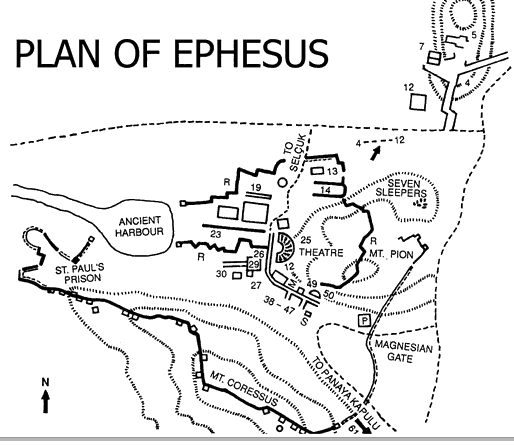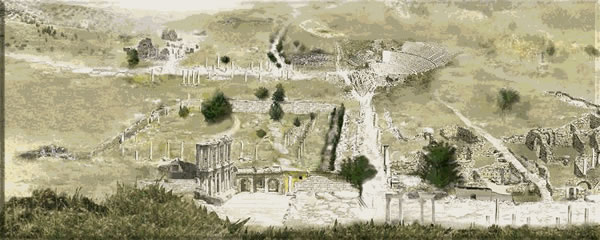
腓、西、弗、門—教會問題(2) : (基督論)
| 日期 |
寫作地點/皇帝 |
書 卷 |
| 監獄中 57-62 |
監獄書信 |
Captivity Letters |
| 57/59 |
該撒利亞 |
|
| 該撒利亞 |
[歌羅西書] |
|
| 60/62 |
羅 馬 |
[以弗所書] |
| 羅 馬 |
||
| 63 |
使徒行傳 |
根據:信中明言受捆鎖(腓1:12-13; 弗3:1, 4:1, 6:20; 西1:24; 門1)
問題:
三卷致教會書信與一卷個人書信的對比:
歌羅西城(Colosse):
它位於亞西亞內陸的一條山脊上,眺望利銳河(Lycus River)河谷,距離希拉波和老底嘉二城不遠。主前五世紀的波希戰爭中,它的地位十分重要。但希拉波(Hieropolis)和老底嘉(Laodica)興起後,它的貿易日漸衰落。歌羅西山麓所產的黑色羊毛也曾盛極一時。(滕慕理,頁257-8)在保羅時代,它仍時一個大城。但因為現在尚未有發掘,所以不少宗教資料是從這一帶的其他城巿類推出來的.
其他網上關於此城的資料.
歌羅西教會(Colossian Church):
歌羅西書大綱:(ABD, p.1090.)
1:1-8 書信的開始段(Letter Opening)
1:9-4:6 書信的本文(Letter Body)
1:9-2:7 確認使徒的福音 (基督論為中心, 慕, 頁258.)
2:8-23 提防假師傅
3:1-4:6 勸勉過基督徒生活
4:7-18 書信的結尾段(Letter Closing)
歌羅西書內容:
那些異端內容是: [ABD, p. 1092.]
學者對這個異端的解釋有多種: 猶太主義者,外邦宗教,或混合宗教。我相信最後那個可能性最能解釋這表述。
網上參考資料:Possible Sources of the Heresy:24
24 There is no way in which one can be certian about the historical origin of this heresy. Morna Hooker even disputed the existence of a heresy in the Colossian church in her paper, "Were There False Teachers in Colossae?" in Christ and Spirit in the New Testament, edited by B. Lindars and S. S. Smalley (Cambridge: Cambridge University Press, 1973), pp. 315-331. However, Bruce seems to be correct when he affirms that "Yes, there were false teachers in Colossae" ("The Colossian Heresy," Bib Sac 141 [1984]: 195; see also Paul: Apostle of the Heart Set Free, p. 413).
| 1. Essenism: | 2. Greek Pagan Cults: | 3. Gnosticism: | 4. Syncretistic Religion: | 5. Jewish Mysticism--the Merkabah Mysticism27 |
a. B. Lightfoot was the major proponent of this position
affirming many parallels between the Heresy and the asceticism of this
Jewish b. Even though there are ome parallels, there is no evidence that they lived in the western portions of Asia Minor c. While this explains the emphasis on higher knowledge and special revelation, it fails to explain the mystical experiences which are apparent in the epistle. |
a. There are many theories along this line of thinking: Neopythagoreanism, mystery religions, pre-Christian Gnosticism, the Iranian Redemption myth, the initiation into the Isis mysteries. b. This is an attempt to emphasize the Hellenism on the church at the time c. While some of these "cults" actually fight against one another, there is no oubt that the Heresy in Colossae was influenced by the Hellenism of their day; it is difficult to be even more specific. |
a. Gnosticism was a religious movement that proclaimed a mystical esotericism for the elect based on illumination and the acquisition of a higher knowledge of things heavenly and divine" 26 b. However, there was not a pre-Christian Gnosticism and it is doubtful that the biblical writers were fighting a known foe called Gnosticism c. There may well have be roots of a Christian Gnosticism (incipient Gnosticism) which later became the Gnosticism of the second and third centuries AD. |
a. The heresy contains a combination of parts of many of the above views wherein Jews and Gentiles are attempting to advance beyond apostolic Christianity b. This view is very possible and perhaps even diplomatic |
b. In order to obtain such a vision it was necessary to observe: |
| 25 J. B. Lightfoot, Saint Paul's Epistles to the Colossians and to Philemon (1879; reprinted, Grand Rapids: Zondervan, 1959), 73-113. |
26 Gershom G. Scholem, Jewish Gnosticism, Merkabah Mysticism, and Talmudic Tradition (New York: Jewish Theological Seminary of America, 1960), p. 1. |
27 F. F. Bruce, "The Colossian Heresy," Bib.Sac.
141 (1984): 201-204. |
其他研究:
以弗所書
以弗所城(Ephesus, Efes):

以弗所書
以弗所書大綱:(ABD, Vol. II. p.536. Victor Paul Furnish)
1:1-23 書信的開始段(Letter Opening)
2:1-6:20 書信的本文(Letter Body)
2:1-3:21確認基督的奧秘
4:1-6:20勸勉過基督徒生活
6:21-24 書信的結尾段(Letter Closing)

其他研究:
〔留意:七十士譯本的經文 ( 但經文的本文可能有不同的版本 , 不是現在的 LXX 的版本 ; 也可能出於他的釋經方式 ; 參希伯來書怎樣運用舊約 (How the Hebrews use the O.T.) 。以下的作者分析時沒有考慮這個可能.〕
𨪜𨪜以弗所書四8引述詩篇六十八18:「所以經上說,他昇上高天的時候,擄掠了仇敵,將各樣的恩賜賞(edoken)給人。」與希伯來文所顯示的時態稍有不同:「你已經昇上('alita)高天,已經擄掠了仇敵(sabita sebi),你在人間……已受了(laqahta)供獻。」保羅是否故意歪曲舊約聖經的意義,他任意竄改舊約經文,豈不是違背了聖經權威及無誤的原則?有些批評聖經的人持上述意見,但他們忽略了詩篇六十八18的上文下理。以弗所書援引並修改舊約經文,他們也沒有考慮到保羅意欲何圖。
𨪜𨪜使人感興趣的是,保羅沒有依照七十士譯本的翻譯,他們亦似乎沒有參照舊約原文。七十士譯本非常忠於原文,將laqahta(曾受了)翻譯為elabes。原文是猶太人傳統上的解經書「亞蘭文他爾根」將laqahta翻譯成yehabta(你轉賜給人)。神不會為自己保留什麼(正如保羅於徒十七25所言,「也不用人手服侍,如像缺少什麼」);剛剛相反,神擁有百般美物,都是要賜給人類。因此,他爾根演繹出這動詞的原意(特別與ba'adam合並時)——在人間賜下恩惠。他爾根簡化了原文,譯為libene nasa(給人的眾子=人類),並解釋此片語的含意為——是人接受神所贈的百物。
𨪜𨪜保羅引用他爾根中的詩篇六十八18,由此看來,他爾根於公元三世紀筆錄成書之前,已循口傳留存於民間。保羅受教於迦瑪列門下,當然熟悉口傳他爾根關於詩篇六十八篇的解釋。而七十士譯本忠於馬所拉抄本,只譯為「人間」(en anthropois)。詹麥臣等人(Jamieson,Fausset,Brown,Commentary)對以弗所書該段經文有以下評述:「你已接受了供獻,再轉贈予人間——勝利者從仇敵處搜掠戰利品,均分給子民。同樣,基督戰勝亡,上昇至高天后,聖靈之恩才廣賜予信徒。」
𨪜𨪜新約聖經引述舊約經文,不一定完全照字面意義直接引述,卻會照著舊約原經文的上文下理,拾取出其含義,引述於新約經文里,以符合新約作者論證所需。以弗所書四8正是這種引述方式的例子。
腓立比書
主題: 福音和喜樂 (鮑會園牧師曾認為本書不是以喜樂為主題: 論據: 喜樂出現很少; 而且不平均.)
腓立比書大綱:慕, 頁262.
1:1-11 書信的開始段(Letter Opening)
1:1-2 問安
1:3-11 感恩段
1:12-4:1 書信的本文(Letter Body)
1:12-2:18 由個人的遭遇而發出勉勵
2:1-30 個人與送信者的關係
3:1-4:1 個人對律法主義的警告
4:2-23 書信的結尾段(Letter Closing)
或參此大綱腓立比書全書大網
背景
保羅在獄中寫這書信(1:13-14),而按照傳統說法,相信是在羅馬被囚時(徒28:16,30)寫作(即約為主後61-62年)。在主後第二世紀的馬吉安的著作已反映這種看法。
『從那裡來到立比,就是馬其頓這一方的頭一個城•也是羅馬的駐防城』(徒 16:12)。加上考古和歷史的資料,這個城是該區一個重要大城巿;而且有大道(Via Egnatia) 直通這巿。也是保羅回應馬其頓異象後(徒16:8-10)的第一個重要城巿。因為猶太男子太少(至少十人才能有會堂);保羅只有在河邊找到祈禱之地方(聚會點)。但這教會一直支持保羅的宣教,超過十年以上。
大網
1 引言 (1: 1-11) (書信体的開始段//加上保羅的特有用法)
2 保羅的處境 (1:12-26)
3 勸勉 (1:27-2:18)
4 保羅的計劃 (2:19-30)
5 警告: 提防假師傅 (3:1-4:1)
6 結尾段 (4:1-9)
其他研究:
David Seeley, The Background of the Philippians Hymn.
腓利門書
腓利門書大綱:慕, 頁254-6.
1:1-3 問安
1:4-7 團契
1:8-20 恩惠
1:21-25 告別
特別分析:
John Paul Heil, The Chiastic Structure and Meaning of Pau's Letter to Philemon , from Biblica 82 (2001) 178-206.
Kenrick-Glennon Seminary
St. Louis, MO 63119-4399 (USA)
John Paul HEIL
SUMMARY
This article proposes a new chiastic structure for Paul's letter to Philemon based on rigorous criteria and methodology. The center and pivot of the chiasm, 𨘀ut without your consent I resolved to do nothing, so that your good might not be as under compulsion but rather under benevolence? (v. 14), is a key to explicating the letter𠏋 supposedly unclear purpose. Paul wants Philemon to give his former slave Onesimus back to Paul as a beloved brother and fellow worker for the gospel of Jesus Christ, because of Philemon𠏋 response to the grace of God evident in his faithful love for the holy ones as a beloved brother and fellow worker of Paul.
?2001 Biblica
Indeed, the Greco-Roman worldview was quite the opposite: it was
predicated on the reality of a world that was bottom-heavy; where the top few
percent were the elite or privileged, and where the rest of humankind was rather
totally dependent on being in good standing with a patron. Seneca, in fact,
said that the giving and receiving of favors was the “practice that constitutes
the chief bond of human society.” Such a worldview is especially in place when
you read Philemon, where Philemon was both Paul’s patron and friend. Because
he was Paul’s patron, Paul asks for the privilege of hospitality; but because
he was a friend, he presumes upon the reciprocity of such friendship to intercede
for the life of Onesimus (since, in another sense, Philemon owed his life to
Paul).
KREITZER, L.J., "The Plutonium of Hierapolis and the Descent of Christ into the 'Lowermost Parts of the Earth' (Ephesians 4,9)", Biblica, Vol. 79(1998) 381-393.